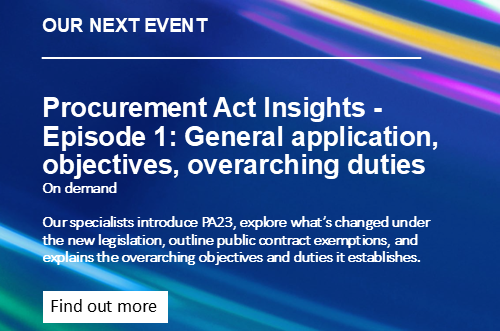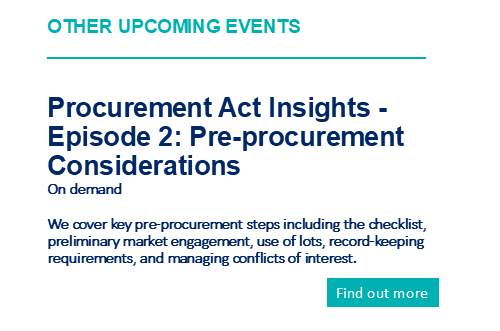- Details
Applying to end the automatic suspension
A recent High Court ruling has provided useful insights into ending the Regulation 95 Contract Making Suspension, writes Colin Ricciardiello.
The recent judgment in Boxxe Limited v Secretary of The State For Justice [2023] EWHC 533 (TCC) provides practitioners with helpful guidance which goes beyond the customary application of the American Cyanamid principles to be applied when ending the automatic contract making suspension. The case considers the recent strand of cases where an expedited trial has been considered as an alternative to ending the suspension; the relevance of the interests of entities who are not parties to the claim, but will be affected by the ending/continuation of the suspension; how to address the sufficiently serious breach requirement in applications to end the suspension.
There was no doubt that the acquisition of the contract in question was one which had an important public interest. It was for the purchase, storage and delivery of digital and audiovisual equipment to be used in Courts. The Claimant (“Boxxe”) came second and challenged the scoring of one element of the winning tenderer’s bid – namely its pricing for the cost of storage.
Serious issue to be tried?
A significant feature of the application to end the suspension was that the Secretary of State for Justice (“SOSJ”) pleaded a time bar defence. That is, its contention that the proceedings had been issued a day late. Accordingly, the first limb of American Cyanamid (is there a serious issue to be tried?) was not satisfied as that potentially “knock out” time bar defence, meant there was no serious issue to be tried. More often than not it is accepted that there is such an issue since the threshold is a low one.
The competing arguments were based on the interpretation of Regulation 92(2) which provides that proceedings must be started within 30 days beginning with the date when the economic operator first knew or ought to have known that grounds for starting the proceedings had arisen. SOSJ argued that since the date of knowledge to start the proceedings arose from the 13 December 2022 award decision notice, the 13th was counted and was the first day of the 30-day period. Therefore, the last day to commence proceedings was 11 January 2023. The proceedings though were commenced on 12 January 2023. Boxxe argued that the 13th was not counted and the first of the 30-day period was 14 December 2022.
The Judge decided that despite the SOSJ advancing a “formidable line of authority” it was inappropriate for him to: “give in to the temptation to decide the matter finally in the context of this application for lifting the suspension. The matter is not so clear cut as to conclude that there is not a serious issue to be tried”. So, this important issue of construction will have to wait for another day when SOSJ’s application to strike out/summary judgment is heard. When judgment on that point is delivered it should also apply after the Procurement Bill becomes law as the time limit provision for starting proceedings is the same.
Were damages an adequate remedy for the Claimant?
As for the next American Cyanamid test of whether damages would be an adequate remedy for Boxxe, Boxxe adduced evidence from its sub-contractor (Involve) who claimed it would suffer losses of around £1.5m if the suspension was lifted. The interest of third parties in the form of the winning tenderer (appearing as interested parties in ending the suspension application or writing letters of support of such applications) has long been a feature in procurement challenges when it comes to considering where the balance of convenience lies[1] – that is who suffers the most prejudice if the suspension is ended or remains in place. Here though, the interests of this third-party sub-contractor were put forward as a reason for saying that damages were not an adequate remedy for Boxxe. That argument was rejected and (citing Circle Nottingham Ltd v. NHS Rushcliffe Clinical Commissioning Group [2019] EWHC 1315 (TCC) concerning whether to take into account losses which may be suffered by a group of companies) it was held that the position of the sub-contractor was irrelevant and should not be taken into account when considering the adequacy of damages for Boxxe.
Since the Supreme Court’s decision in Nuclear Decommissioning Authority v ATK Energy EU Ltd [2017] UKSC 34 a Claimant no longer has an automatic right to damages – the breach has to be sufficiently serious (known as the Francovich conditions). If the contract making suspension is lifted then the Claimant might not have an effective remedy in damages if the breach did not satisfy the Francovich conditions[2]. Here, SOSJ did plead in its defence that the breaches were not sufficiently serious in Francovich terms. If that point prevailed at trial then damages would prove not be an adequate remedy for Boxxe. The judgment in Braceurself Limited v NHS England [2022] EWHC 2348 (TCC)[3] demonstrated that there is a hard-edged reality to this sufficiently serious breach threshold in cases where the suspension is ended but no damages are awarded at trial - even where a breach causative of loss was established at trial it was held not to be sufficiently serious to warrant an award of damages. Whilst the judge was careful to state it was not right to follow Boxxe’s submission that every time the issue of whether a breach satisfied the Francovitch condition arose, damages are automatically rendered inadequate for the purposes of considering whether to lift the suspension, the fact remained that potentially a claimant could be left without an adequate remedy. This was addressed by SOSJ undertaking not to pursue its pleading that the breaches did not satisfy the Francovitch conditions.
Speedy trial as an alternative to ending the suspension
Said to be based on the approach in Draeger Safety UK Ltd v. The London Fire Commissioner [2021] EWHC 2221 (TCC), Boxxe “cross-applied” for a speedy trial and to keep the suspension pending the trial as part of the balance of convenience test, even if damages were clearly an adequate remedy. The orthodox approach being if damages were adequate then the balance of convenience test is not even considered. The approach that a speedy trial is a kind of pragmatic alternative to ending the suspension had been rejected in previous judgments[4] even if the court could accommodate an expedited trial. Accommodating an expedited trial “… may provide a pragmatic solution where matters are finely balanced, that balancing exercise does not arise in circumstances where it is clear that damages are an adequate remedy”.
In Draeger (where the suspension was maintained and an expedited trial was ordered) the contract was high profile[5] and arguably damages were not an adequate remedy and so the availability of an expedited trial became part of the balance of convenience exercise.
Difficulty in assessing Boxxe’s damages
Remarkably, even though Boxxe pleaded its quantified damages precisely down to pennies, it still argued that quantification would be difficult and so damages were not an adequate remedy. This argument was rejected – not least because, following the line of established authority, the court is adept at assessing evidence and coming to a balance of probability conclusions on the counterfactual.
Would damages be an adequate remedy for SOSJ?
The other side of the coin on adequacy for the Claimant is whether damages (through an undertaking in damages from the Claimant) would be adequate for the Defendant if ultimately it suffers loss by reason of the suspension being maintained. On the facts, even if there was an expedited trial, the loss of the first year of funding, delays to improvements of functionality and the like, could not be compensated by an award as to damages. Damages were accordingly held not to be an adequate remedy for SOSJ.
Balance of convenience
Applying ordinary principles, having found that damages would be an adequate remedy (fortified by the undertaking not to take the Francovich sufficiently serious point) this further test did not have to be considered. Nevertheless, the Judge clearly stated that ending the suspension carried the least risk of injustice because:
- If the suspension was ended, damages would be an adequate remedy for Boxxe if it succeeded at trial;
- If the suspension was not ended, with or without an expedited trial, SOSJ’s losses could not be compensated in damages;
- The public interest pointed towards both ending and maintaining the suspension so that point was neutral;
- The winning tenderer would be adversely affected by the suspension remaining.
Conclusions
This is an important judgment on the ending of a suspension application as it provides guidance on: how to manage the inter-play between a Francovich defence and the damages being an adequate remedy test by offering an undertaking; the relevance of the interests of a party related to the losing tenderer; when an expedited trial might be appropriate instead of ending the suspension.
Colin Ricciardiello is a Partner at Sharpe Pritchard.
[1] OpenView v LB of Merton [2015] EWHC 2694 at (14) – the interests of the winner are relevant and that is why the court should be slow to maintain the suspension even if they are not added as an Interested Party. Medequip v RBKC [2022] EWHC 3293 (TCC) at (49) – the interests of the successful tenderer are taken into account when assessing where the balance of convenience lies.
[2] A number of cases have considered the impact of the sufficiently serious requirement on whether damages were an adequate remedy – see for example Lancashire Care NHS Foundation Trust v Blackpool Teaching Hospitals NHS Foundation Trust [2018] EWHC 200 (TCC) and Alstom Transport UK Ltd v Network Rail Infrastructure Ltd [2019] EWHC 3585 (TCC).
[3] Braceurself is subject to a pending appeal.
[4] OpenView at (25) and (27) if damages were an adequate remedy, the period of the trial should not be an influential factor or reason to maintain the suspension though special cases may arise. Kellogg Brown & Root Ltd v Mayor’s Office for Policing & Crime [2021] EWHC 3321 at (38) and (39), the argument that a swift trial is a pragmatic solution and should be brought into account when considering the justice of the case in the context of the adequacy of damages was rejected and there was no authority that the normal rule as to the adequacy of damages should be displaced by a prompt trial.
[5] See Sysmex (UK) Ltd v Imperial College Healthcare NHS Trust [2017] EWHC 1824 (TCC) at (23) for a discussion on the loss of prestigious contracts and damage to the unsuccessful tenderer’s reputation in the context of damages not being an adequate remedy.
For further insight and resources on local government legal issues from Sharpe Pritchard, please visit the SharpeEdge page by clicking on the banner below.
This article is for general awareness only and does not constitute legal or professional advice. The law may have changed since this page was first published. If you would like further advice and assistance in relation to any issue raised in this article, please contact us by telephone or email
|
Click here to view our archived articles or search below.
|
|
ABOUT SHARPE PRITCHARD
We are a national firm of public law specialists, serving local authorities, other public sector organisations and registered social landlords, as well as commercial clients and the third sector. Our team advises on a wide range of public law matters, spanning electoral law, procurement, construction, infrastructure, data protection and information law, planning and dispute resolution, to name a few key specialisms. All public sector organisations have a route to instruct us through the various frameworks we are appointed to. To find out more about our services, please click here.
|
|
OUR RECENT ARTICLES
December 10, 2025
Sharpe Pritchard appointed to £60m London Boroughs’ Legal Alliance frameworkSharpe Pritchard, one of the UK’s leading public law firms, has been re-appointed to the London Boroughs’ Legal Alliance (LBLA) Solicitors Panel.
November 20, 2025
Strengthening the standards and conduct framework for local authorities in EnglandJames Berry offers his insight into how the proposed changes to standards and conduct rules will affect local authorities.
November 04, 2025
Procuring and operating open frameworks under the Procurement Act 2023Chantelle Pink offers advice to authorities on open frameworks and how to procure them.
October 31, 2025
Building Solar – 5 Top Tips for Solar Farm Construction ContractsSolar farm construction contracts are in focus following fascinating insights into the continuing global uptake and expansion of renewables, and particularly solar, within the 2025 mid-year report of Ember, a global energy think tank.
|
|
OUR KEY LOCAL GOVERNMENT CONTACTS
|
||
|
Partner 020 7406 4600 Find out more |
||
|
Partner 020 7406 4600 Find out more |
||
|
Rachel Murray-Smith Partner 020 7406 4600 Find out more |







 Catherine Newman
Catherine Newman
